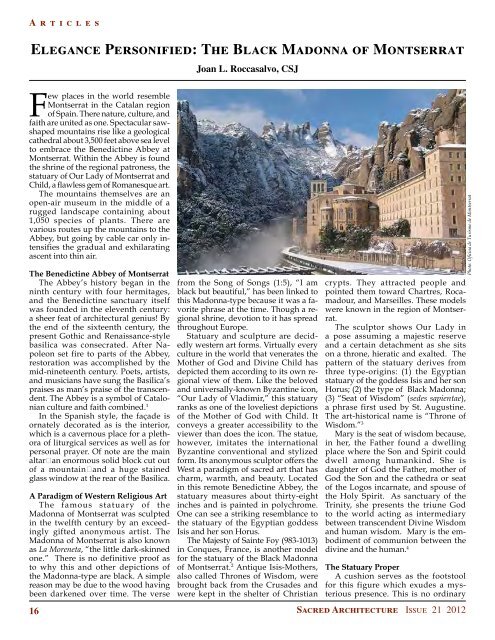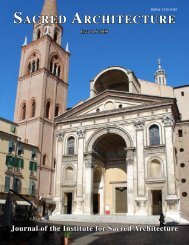ArticlesElegance Personified: <strong>The</strong> Black Madonna of MontserratJoan L. Roccasalvo, CSJFew places in the world resembleMontserrat in the Catalan regionof Spain. <strong>The</strong>re nature, culture, andfaith are united as one. Spectacular sawshapedmountains rise like a geologicalcathedral about 3,500 feet above sea levelto embrace the Benedictine Abbey atMontserrat. Within the Abbey is foundthe shrine of the regional patroness, thestatuary of Our Lady of Montserrat andChild, a flawless gem of Romanesque art.<strong>The</strong> mountains themselves are anopen-air museum in the middle of arugged landscape containing about1,050 species of plants. <strong>The</strong>re arevarious routes up the mountains to theAbbey, but going by cable car only intensifiesthe gradual and exhilaratingascent into thin air.<strong>The</strong> Benedictine Abbey of Montserrat<strong>The</strong> Abbey’s history began in theninth century with four hermitages,and the Benedictine sanctuary itselfwas founded in the eleventh century:a sheer feat of architectural genius! Bythe end of the sixteenth century, thepresent Gothic and Renaissance-stylebasilica was consecrated. After Napoleonset fire to parts of the Abbey,restoration was accomplished by themid-nineteenth century. Poets, artists,and musicians have sung the Basilica’spraises as man’s praise of the transcendent.<strong>The</strong> Abbey is a symbol of Catalonianculture and faith combined. 1In the Spanish style, the façade isornately decorated as is the interior,which is a cavernous place <strong>for</strong> a plethoraof liturgical services as well as <strong>for</strong>personal prayer. Of note are the mainaltar―an enormous solid block cut outof a mountain―and a huge stainedglass window at the rear of the Basilica.A Paradigm of Western Religious Art<strong>The</strong> famous statuary of theMadonna of Montserrat was sculptedin the twelfth century by an exceedinglygifted anonymous artist. <strong>The</strong>Madonna of Montserrat is also knownas La Moreneta, “the little dark-skinnedone.” <strong>The</strong>re is no definitive proof asto why this and other depictions ofthe Madonna-type are black. A simplereason may be due to the wood havingbeen darkened over time. <strong>The</strong> versefrom the Song of Songs (1:5), “I amblack but beautiful,” has been linked tothis Madonna-type because it was a favoritephrase at the time. Though a regionalshrine, devotion to it has spreadthroughout Europe.Statuary and sculpture are decidedlywestern art <strong>for</strong>ms. Virtually everyculture in the world that venerates theMother of God and Divine Child hasdepicted them according to its own regionalview of them. Like the belovedand universally-known Byzantine icon,“Our Lady of Vladimir,” this statuaryranks as one of the loveliest depictionsof the Mother of God with Child. Itconveys a greater accessibility to theviewer than does the icon. <strong>The</strong> statue,however, imitates the internationalByzantine conventional and stylized<strong>for</strong>m. Its anonymous sculptor offers theWest a paradigm of sacred art that hascharm, warmth, and beauty. Locatedin this remote Benedictine Abbey, thestatuary measures about thirty-eightinches and is painted in polychrome.One can see a striking resemblance tothe statuary of the Egyptian goddessIsis and her son Horus.<strong>The</strong> Majesty of Sainte Foy (983-1013)in Conques, France, is another model<strong>for</strong> the statuary of the Black Madonnaof Montserrat. 2 Antique Isis-Mothers,also called Thrones of Wisdom, werebrought back from the Crusades andwere kept in the shelter of Christiancrypts. <strong>The</strong>y attracted people andpointed them toward Chartres, Rocamadour,and Marseilles. <strong>The</strong>se modelswere known in the region of Montserrat.<strong>The</strong> sculptor shows Our Lady ina pose assuming a majestic reserveand a certain detachment as she sitson a throne, hieratic and exalted. <strong>The</strong>pattern of the statuary derives fromthree type-origins: (1) the Egyptianstatuary of the goddess Isis and her sonHorus; (2) the type of Black Madonna;(3) “Seat of Wisdom” (sedes sapientae),a phrase first used by St. Augustine.<strong>The</strong> art-historical name is “Throne ofWisdom.” 3Mary is the seat of wisdom because,in her, the Father found a dwellingplace where the Son and Spirit coulddwell among humankind. She isdaughter of God the Father, mother ofGod the Son and the cathedra or seatof the Logos incarnate, and spouse ofthe Holy Spirit. As sanctuary of theTrinity, she presents the triune Godto the world acting as intermediarybetween transcendent Divine Wisdomand human wisdom. Mary is the embodimentof communion between thedivine and the human. 4<strong>The</strong> Statuary ProperA cushion serves as the footstool<strong>for</strong> this figure which exudes a mysteriouspresence. This is no ordinary16 <strong>Sacred</strong> <strong>Architecture</strong> <strong>Issue</strong> 21 2012Photo: Oficina de Turisme de Montserrat
Articlesregal figure. Mother and Child are depictedin their idealistic attributes andnot as figures of sentimentality. As asign of asceticism, the Mother’s body isslender, even thin. Her elongated faceexpresses delicate features: eyes alertand wide-open, petite nose, slightly-curved,depressed in the middle,and an upturned tip. Mary’s fulsomecheeks symbolize plenitude and joy asshe reveals her delight in being herselfand in being the Child’s mother. Hersmile suggests deep satisfaction, redolentof her Magnificat where she recognizesher privileged stature in beingsingled out among women. Her quiet,jubilant face contrasts sharply fromthat of the Mater Dolorosa, the sorrowfulMother, a role she will laterassume. But <strong>for</strong> the present, she enjoysher exalted position as do we, togetherwith the Christ-Child. Like OurLady of Vladimir, the light, radiatingover Mary’s black face, makes herentire visage sparkle with radiance. Inkeeping with the period, her headdressis draped, and beneath the crown, aveil adorned with stars, squares, andstripes in subtle polychrome. <strong>The</strong> golden-edgedborder falls symmetrically,encircling her face like a halo that highlightsher delicate features. Tunic andcloak gracefully envelop her slendershoulders. Our queen of heaven andseat of wisdom holds an orb of theearth in her right hand, while the otherhand, gracefully cupped and extended,monitors the Child’s left side. It is impossibleto grasp her inner composure,a stunning beauty in one glance. Hereis elegance personified.<strong>Sacred</strong> <strong>Architecture</strong> <strong>Issue</strong> 21 2012Not surprisingly, the Child is depictedas the God-Man. His hand israised giving the <strong>for</strong>malized and traditionalEastern blessing, three fingersraised (symbolizing the Trinity) andtwo folded inward to the palm (symbolizingthe two natures of the Godman).Like his mother, the Childexpresses contentment. He does notgrasp his mother but is shown frontallyand is firmly seated between his mother’slegs. Though barefooted, he wearsa crown and regal garments. Curiouslyenough, the thin draped coveringof their legs accents the knees of bothfigures with feet firmly on the ground.<strong>The</strong> sculptor has portrayed a classicMother and Child accessible to us evenas their aesthetic distance remains inplace. <strong>The</strong> verticality, mass, density,balance and symmetry render the statuarya peerless beauty and one capableof bringing its beholders to their knees.Saint Ignatius of Loyola at MontserratDevotion to this image of Our Ladyhas wrought many miracles, as withthe founder of the Society of Jesus, theJesuit Order. Shortly after his remarkablere-conversion to Christianity, thesoldier Ignatius of Loyola was determinedto join the army of Christ andwent to Montserrat to make his consecration.Be<strong>for</strong>e the beautiful BlackMadonna, Ignatius trans<strong>for</strong>med theancient ceremony <strong>for</strong> the making of aknight into the “new soldier of Christ.” 5In pilgrim’s garb and in keeping withthe chivalric code, he kept an allnightvigil there. In March 1522, heplaced his sword be<strong>for</strong>e the statue ofthe Mother of God, stood, knelt, sanghymns and prayed with the other pilgrims.6 Ignatius began his new life inGod under the inspiration of the beautifulstatuary which thousands todayrevere.Monastic Apostolic Works<strong>The</strong> Abbey’s eighty monks dedicatetheir works to the service of theChurch and country. Not surprisingly,the monks make Spanish liqueurs andother delicacies. <strong>The</strong>ir library and scriptoriumcontain 300,000 volumes withabout 400 incunabula. <strong>The</strong> Abbey’smuseum contains five collections: archeological,iconographical, gold andsilver articles, antique paintings of thefifteenth through the eighteenth centuries,and modern painting and sculpturesof the nineteenth and twentiethcenturies. <strong>The</strong> monks are committedto pay special attention to pilgrimsand provide accommodation adaptedto everyone’s needs and budgets. Asone of the oldest Abbey music schoolsin Europe, Montserrat boasts of aboutfifty choir boys who receive excellentmusic training added and integratedwith their general education. At nooneach day, they sing the Hymn to Virgin,the virelai, “Rosa d’abri” that beginswith the phrase, “<strong>The</strong> Virgin, the skinglistened,Black Madonna, soaring upover the peaks . . . .”A pilgrimage to Montserrat cannever be <strong>for</strong>gotten; it is etched intothe memory <strong>for</strong> immediate recall andsavored time and again. It is a feast <strong>for</strong>the eyes, revealing beauty that leads toprayer.Sister Joan Roccasalvo, CSJ holds Ph.D’s inmusicology and liturgical studies andwrites a weekly column entitled “<strong>The</strong> Wayof Beauty” <strong>for</strong> the Catholic News Agency.(Endnotes)1. “Montserrat: Nature, Culture, Spirituality,” booklet publishedby the Montserrat Tourist Agency.2. <strong>The</strong> reliquary statue of Sainte-Foy is made of wood coveredwith metal and gemstones, glorified bodies being the preciousstones of the heavenly Jerusalem wood, gold leaf; preciousstones, pearls, enamel; she sits on a throne with her feet on afootstool and her hands outstretched. See Maurice Dilasser, <strong>The</strong>Symbols of the Church, translated by Mary Cabrini Durkin, OSU,Madeleine Beaumont, and Caroline Morson (Collegeville, MN: ALiturgical Press Book, 1999), 78.3. Catherine Combier-Donovan, “Mary, Throne of Wisdom:Twelfth-Century Statue, Twenty-First Century Icon,” EnvisionChurch, Jan, 2009.4. Catechism of the Catholic Church, 721.5. Pedro Leturia, Iñigo de Loyola (Syracuse: Le Moyne CollegePress, 1949), 95.6. James Brodrick, St. Ignatius Loyola: <strong>The</strong> Pilgrim Years, 1491-1538(New York: Farrar, Straus & Cudahy, 1956), 86.17










